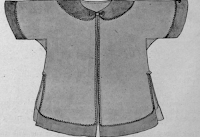
First, the progress – the bodice is sewn together, the sleeves assembled, wings on, and sleeves set in. They still pull the tiniest bit at the shoulders, causing the shoulder seams to bow upwards at the neck, despite putting in a considerable curve at the top of the sleeve head. Pooey! I pinched in the shoulder seams at the neck, which will hopefully remedy this problem.

I have not put in the lining (sorry with this blown out and blurry photo!), but that’s next. You can see the godets sewn in, and the lining will be hand stitched around them. I’ll put it in by machine on the neck edges, turn it, and hand-sew down the seams. Then it’s just on to the placket (as if that isn’t the HARDEST PART), the buttons, and turning up the hem.
So now, what I wanted to talk about. The illustrious Jennie Page of New Zealand called to my attention “godets,” as opposed to “gussets,” … and then there’s “gores.” What are these things? How are they different from one another? Well here is the primer:

What is a Gusset?
A gusset is a square or rectangular piece of fabric set into the seams of a garment, to expand the garment and reduce the stress if it’s too tight-fitting. Gussets are used at the shoulders, under the arms, and at the hems of garments, and are functional insets. A good example is the gussets you find under the arms of medieval tunics, gowns, and in later shirts and chemises.

What is a Godet?
A godet is a triangular piece of fabric set into the hem of a garment, typically a skirt, to cause it to flare. Godets are usually rounded on the bottom, and create a more circular shape to the hem. The triangular bits set into the 17th c. jacket are GODETS, not gussets, so I stand corrected!

What is a Gore?
This is a little more complicated, but in sewing, a gore is a trapezoidal or roughly triangular piece of fabric that when combined with others creates a 3-dimendional shape, such as a skirt that flares at the hem. The flare is created of a piece with the pattern pieces, instead of by using additions such as godets.



5 Comments
An Historical Lady
August 11, 2010 at 9:34 PMThis comment has been removed by the author.
GentlewomanThief
August 12, 2010 at 1:36 PMAhh, thank you for that primer – I already feel more enlightened! I was muchly puzzled by those three terms.
And the jacket! It is looking FAB.U.LOUS. 😀
Robin Gallowglas
August 12, 2010 at 6:34 PMWhat a fantastic post Lauren! Great information, Thank you!
American Duchess
August 12, 2010 at 6:37 PMYay, glad you guys liked it! I was worried I'd be wasting blog-space…I mean, I didn't know the difference between a gusset and godet, now I do, but seems like I was the last one on the boat!
Chelly Wood
September 25, 2022 at 5:45 AMI did know that gussets, gores, and godets each had their own terminology, but there’s something to be said for “real time” language and its usage.
The art of sewing was passed on from one person to another throughout history, and as so many family sewists were women — the gender least educated in most western cultures — these gusset-like terms were often grouped together under an umbrella term of “gusset.”
So I wouldn’t worry about being correct or incorrect. If you’ve got enough knowledge to create the garment in a way that makes it fit, what you call the pieces of the garment is really irrelevant. It’s the finished product that counts.